Whales and Marine Mammals in Pismo Beach
From the PBSEO Activity Book Volume 1, you learned how to tell the difference between a Humpback Whale and Gray Whale by connecting the dots to draw the shape of the whales’ spouts. You learned that there are Blue Whales, Minke Whales, Orcas, Dolphins, Porpoises, Harbor Seals, Northern Elephant Seals, California Sea Lions, and Southern Sea Otters inhabiting the marine waters along the California Coast. Also, you learned the importance of observing Marine Wildlife Viewing Safety Guidelines below:
DON’T FORGET THE MARINE WILDLIFE VIEWING SAFETY GUIDELINES
- Keep a distance of at least 100 yards from animals and use binoculars for closer viewing.
- Do not swim with, ride, pet, touch, or attempt to interact with any marine mammals.
Now, let’s learn more about the marine mammals living along the coast of Pismo Beach:
Humpback whales (also known as Hunchbacked Whales; Hump Whales; Bunch Whales)
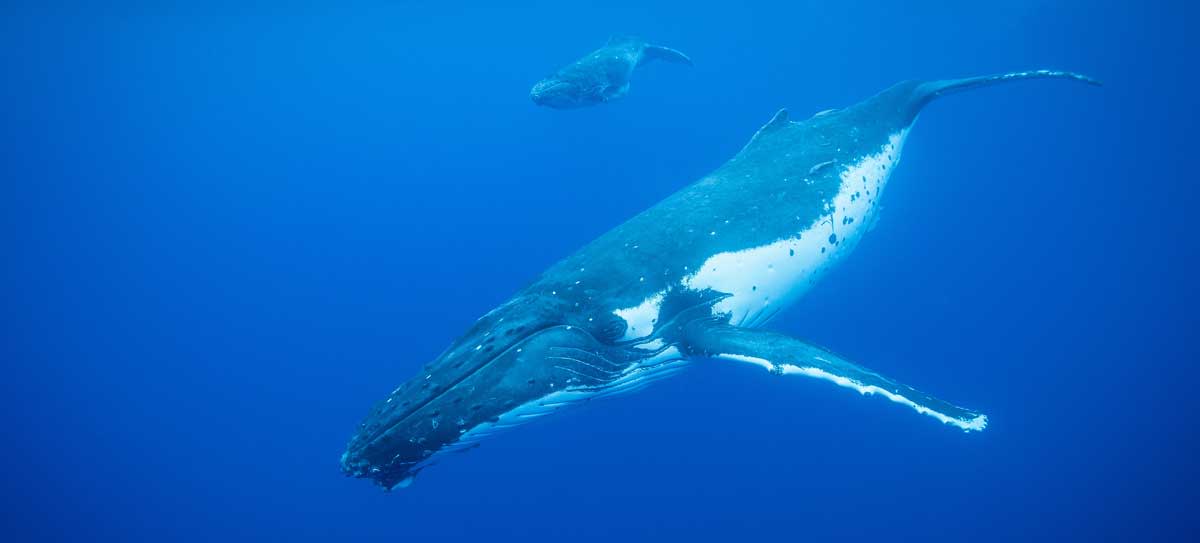 Humpback Whales are titanic whales known for their long complex songs composed of beautiful melodies and their ability to perform impressive acrobatics.
Humpback Whales are titanic whales known for their long complex songs composed of beautiful melodies and their ability to perform impressive acrobatics.
An identifying feature of these enormous dark whales is their giant tail. Males and females reach up to 55 feet long (17 meters) and can weigh up to 80,000 pounds (36,000 kilograms). At birth, humpback calves are up to 15 feet long (4.5 meters) and weigh up to 2,000 pounds (900 kilograms).Their gigantic pectoral flippers are used for swimming, slapping, and regulating body temperature. Humpbacks can also be identified individually by their unique markings located on the underside of their tails. Their heads are covered by knobby tubercles that contain a single hair, much like cat’s whiskers. Tubercles are the whale’s sensory tools providing information about their surroundings.
Of all the types of whales, humpback whales have one of the longest migrations of any mammal on earth traveling thousands of miles each year. In the northern hemispheres, whales feed in cold waters before heading south to breed in warmer waters. Most populations undertake huge annual migrations, moving between mating and calving grounds in warmer, tropical waters, and feeding grounds in colder, more bountiful waters. Covering such huge distances, humpback whales are constantly exposed to a number of threats and must navigate life-threatening dangers, that include whalers, fishing nets and ships.
Humpback whales' prey are microscopic and they can consume up to 3,000 pounds (1,360 kilograms) of food each day. Humpbacks feast on plankton, krill, and other small fish by gulping enormous mouthfuls of prey and seawater and filtering the water through their baleen plates.
Humpback whales are found in all the world’s major oceans. Like other sea mammals, humpback whales were hunted extensively, almost to extinction. Today, humpbacks are still hunted in St. Vincent and the Grenadine Islands in the eastern Caribbean where their flesh and their blubber is used for snacks called crisps, made into cooking oil, and used for their medicinal purposes. Though Humpback whales’ numbers have increased in the Atlantic, in the Pacific Northwest they are considered endangered.
The best time to watch Humpback whales migrating through Pismo Beach is April through November. Don’t forget to watch for their single burst of spray!
Minke whales
 Minke Whales are the smallest of the baleen whales weighing up to 20,000 pounds (9,072 kilograms), growing up to 35 feet in length (11 meters), and living up to 50 years of age
Minke Whales are the smallest of the baleen whales weighing up to 20,000 pounds (9,072 kilograms), growing up to 35 feet in length (11 meters), and living up to 50 years of age
Minke whales have black to dark gray-brown bodies with a pale chevron on their backs, behind their heads, and above the flippers, and their underside is white. They have a tall, sickle-shaped dorsal fin located about two-thirds down their back. Calves are usually darker in coloration than adults. Minke whales often surface snout-first. Their blow is small and soft, reaching only about 6.5 feet (2 meters) to 10 feet (3 meters) high. Minke whales can be seen traveling alone or in small groups of two to three. Minke whales are curious and may approach vessels, especially stationary ones. Minke whales feed on crustaceans, plankton, and small schooling fish by gulping seawater and filtering it through their baleen. Minke whales vocalize by creating sounds that include clicks, grunts, pulse trains, ratchets, thumps, and recently discovered "boings."
Though Minke Whales are not considered endangered in the United States because of their stable population size, they are still protected by the Marine Mammal Protection Act (MMPA). Threats to their well being include, entanglement in fishing gear, climate change, ocean noise, pollution, vessel strikes, and whaling. Though a small number of Minke Whales are taken for subsistence by Alaska Natives, there is concern that their numbers are being depleted due to modern day whaling and hunting.
See Minke Whales in Pismo Beach year round, however, summer through fall is noted for the majority of sightings.
Blue Whales
 Blue whales are baleen whales, and are the largest animal on Planet Earth weighing on average 200,000 to 300,000 pounds (90,718 kilograms to 136,078 kilograms). A Blue whale’s heart alone weighs around 1,000 pounds (45,359 kilograms). Most Blue whales sighted are 80 to 90 feet long (24 meters to 27 meters), with some recordings of individual whales growing to over 100 feet long (30 meters). Blue whales feed on 12,000 pounds per day of krill, a small crustacean of the order Euphausiacea. Once a female Blue whale reaches around 5 to 15 years old, she can give birth every two to three years with the gestational time lasting about 12 months. Newborn Blue whales are about 23 feet in length (7 meters) and can weigh 5,000 to 6,000 pounds (2,268 kilograms to 2,722 kilograms). The calves gain weight at a rate of up to 10 pounds an hour (5 kilograms), resulting in over 250 pounds a day (113 kilograms). Calves will stay with their mothers until they are six to seven months old. The life expectancy of Blue whales is estimated to be between 80 to 90 years.
Blue whales are baleen whales, and are the largest animal on Planet Earth weighing on average 200,000 to 300,000 pounds (90,718 kilograms to 136,078 kilograms). A Blue whale’s heart alone weighs around 1,000 pounds (45,359 kilograms). Most Blue whales sighted are 80 to 90 feet long (24 meters to 27 meters), with some recordings of individual whales growing to over 100 feet long (30 meters). Blue whales feed on 12,000 pounds per day of krill, a small crustacean of the order Euphausiacea. Once a female Blue whale reaches around 5 to 15 years old, she can give birth every two to three years with the gestational time lasting about 12 months. Newborn Blue whales are about 23 feet in length (7 meters) and can weigh 5,000 to 6,000 pounds (2,268 kilograms to 2,722 kilograms). The calves gain weight at a rate of up to 10 pounds an hour (5 kilograms), resulting in over 250 pounds a day (113 kilograms). Calves will stay with their mothers until they are six to seven months old. The life expectancy of Blue whales is estimated to be between 80 to 90 years.
Blue whales are long and sleek with one small dorsal fin and long pectoral flippers. Blue whales appear light blue in the water when they are actually gray. Cold water diatoms attach to their bellies giving it a yellow cast. They’re often found swimming individually but more commonly in pairs.
Blue whales are listed as an endangered species. They were hunted to the brink of extinction throughout the 20th Century for their blubber, until in 1966, when the International Whaling Commission declared them protected worldwide. Today, with protections, the population has grown to about 3,000 to 4,000 blue whales inhabiting the Northern Hemisphere. Blue Whales continue to face threats today by ship strikes, fishing gear entanglement, and ocean trash.
Despite their small numbers, Blue whales can be seen off the California Coast from summer through fall as they migrate and feed. According to the National Oceanic and Atmospheric Administration (NOAA), one of the largest gatherings of Blue whales worldwide, is estimated to be more than 1,500 blue whales feeding along the California coast.
From both the Pismo Pier and shore, you can see the Blue Whales migrating south from December through February, and migrating north from March through May. Look for the Whale Trail sign on the Pismo Pier!
Gray whales
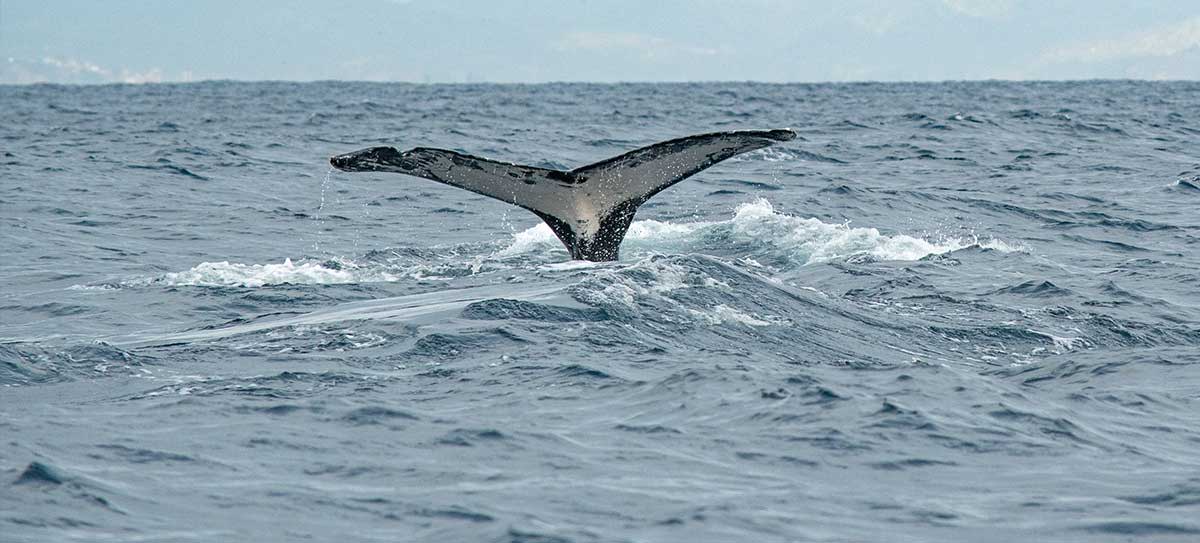 Gray whales were called by their nemesis whalers “Devil Fish” because of their aggressive response to being harpooned. Today, they are known for being gregarious and curious when visited by boats. Gray whales received their name on account of their gray skin, that’s marbled with white patches. These white patches are made up of barnacles and whale lice (small skeleton shrimp). Gray whales have two blow-holes and a low dorsal hump followed by a row of bumps down their backs. Their pectoral fins are oar-shaped that taper into points and their tail flukes are wide and shaped like Cupid’s bow. Gray whales can be identified in the water by their heart-shaped burst of spray from their two blow-holes and their characteristic series of bumps that trace down their backs to their flukes. Gray whales are commonly found in the shallow coastal waters of the north Pacific Ocean.
Gray whales were called by their nemesis whalers “Devil Fish” because of their aggressive response to being harpooned. Today, they are known for being gregarious and curious when visited by boats. Gray whales received their name on account of their gray skin, that’s marbled with white patches. These white patches are made up of barnacles and whale lice (small skeleton shrimp). Gray whales have two blow-holes and a low dorsal hump followed by a row of bumps down their backs. Their pectoral fins are oar-shaped that taper into points and their tail flukes are wide and shaped like Cupid’s bow. Gray whales can be identified in the water by their heart-shaped burst of spray from their two blow-holes and their characteristic series of bumps that trace down their backs to their flukes. Gray whales are commonly found in the shallow coastal waters of the north Pacific Ocean.
Male Gray whales can reach up to 49 feet (15 meters) in length and weigh up to 99,208 pounds (45,000 kilograms). Female Gray whales can measure up to 46 feet (14 meters) in length and weigh up to 99,208 pounds (45,000 kilograms). Baby Gray whales, called calves, are born with a dark gray to black color and are about 16 feet (4.9 meters) in length and weigh up to 1,500 pounds (680 kilograms). Female Gray whales reach sexual maturity between the ages of 6 and 12 years old and give birth every one to three years. The gestation period for a Gray whale is 13.5 months and the calf will remain with its mother for approximately 7 months. The average life expectancy of a Gray whale is unknown, however, one female Gray whale was reported to have died at 75 to 80 years of age.
Gray whales are baleen whales, meaning that they eat small invertebrates, like krill, crab larvae, and mysid shrimp. They forage along the ocean floor for their small prey and then they lean their head to one side to suck up sediment and then filter it and water out through their baleen plates so only their food remains.
Every year, Gray whales engage in one of the world’s longest migrations, a year-round trip between 9,321 miles (15,000 kilometers) and 12,427 miles (20,000 kilometers) long. After spending the summer feeding in the Arctic, the whales begin their journey down the Pacific Northwest to warm Baja California, where they mate and give birth to their calves. Then, once the calves are strong enough, they begin their journey back north. These mother whales travel closely to shore and are known for being fierce protectors of their calves. Their close proximity to the shore makes Gray whales easy to observe for whale watchers and beachgoers alike. Gray whales can be observed from California’s coast on their journey south in December and January, and then again from February to May, with March and April hosting the most sightings in California.
In the western hemisphere, Gray whales are considered endangered. They are threatened by human-caused pollution from trash, oil spills, and chemicals; the whaling industry; noise pollution from military sonar, oil and gas drilling; vessel strikes from shipping; and entanglement in fishing gear.
The best time to watch Gray whales migrating through Pismo Beach is during the spring, with March and April offering the most sightings. Look carefully for their heart-shaped spout!
Dolphins and Porpoises
 On the coast of California, eleven species of dolphins and porpoises can be found. Dolphins and porpoises are toothed whales. They are both members of the same scientific order, Cetacea, that includes all whales. Interestingly, when you spot a dolphin pod, only about a third of a pod is visible with the other two-thirds underwater.
On the coast of California, eleven species of dolphins and porpoises can be found. Dolphins and porpoises are toothed whales. They are both members of the same scientific order, Cetacea, that includes all whales. Interestingly, when you spot a dolphin pod, only about a third of a pod is visible with the other two-thirds underwater.
Dolphins in California’s coastal waters include: Short-beaked common dolphin, Long-beaked common dolphin, Risso’s dolphin, Pacific white-sided dolphin, Pantropical spotted dolphin, Striped dolphin, Rough-toothed dolphin, Common bottlenose dolphin, Northern right whale dolphin, Killer whale, False killer whale, and Short-finned pilot whale. Porpoises in California’s coastal waters include Dall’s Porpoise and the Harbor porpoise.
Off California’s Central Coast, Pacific White-sided dolphins are easily recognized by their dark gray color with white sides, and a broad-based dorsal fin. They gather together in the hundreds as do other mid-sized dolphins. The other commonly found species is the Dall’s Porpoise. They are smaller and stockier than White-sided Dolphins and are often found in small herds. These porpoises do not engage in leaps like dolphins, however, they can still be identified because they travel so quickly that they leave a “rooster-tail” spray in their wake.
Echolocation is used by both dolphins and porpoises to navigate and find food. Both are toothed whales, therefore carnivores, that hunt and consume a variety of prey, consisting predominantly of schooling fish like herring, mackerel, and squid.
Note the differences between Dolphins and Porpoises:
Snouts: Dolphins have beak-like, pointed snouts. Porpoises have blunt, rounded snouts.
Fins: Dolphins have dorsal fins that are rounded and curved. Porpoises have triangular dorsal fins, similar to a shark.
Teeth: Dolphin teeth are cone-shaped. Porpoise teeth are flat and rectangular.
Communication: Dolphins use a wide range of whistles and clicks for communication with other dolphins. They also have a special “signature whistle” to identify themselves. These whistling sounds are made through dolphin’s blowholes to communicate with one another underwater. Porpoises use high-pitched clicks for communication and do not use whistles possibly because of structural differences in their blowholes.
Dolphins and porpoises are present off the coast of Pismo Beach all year long. Dolphins can be seen from the Pismo Beach Pier and the shore. Porpoises might be a bit more challenging to spot, however, keep an eye out for their “rooster tail” spray!
Northern Elephant Seals
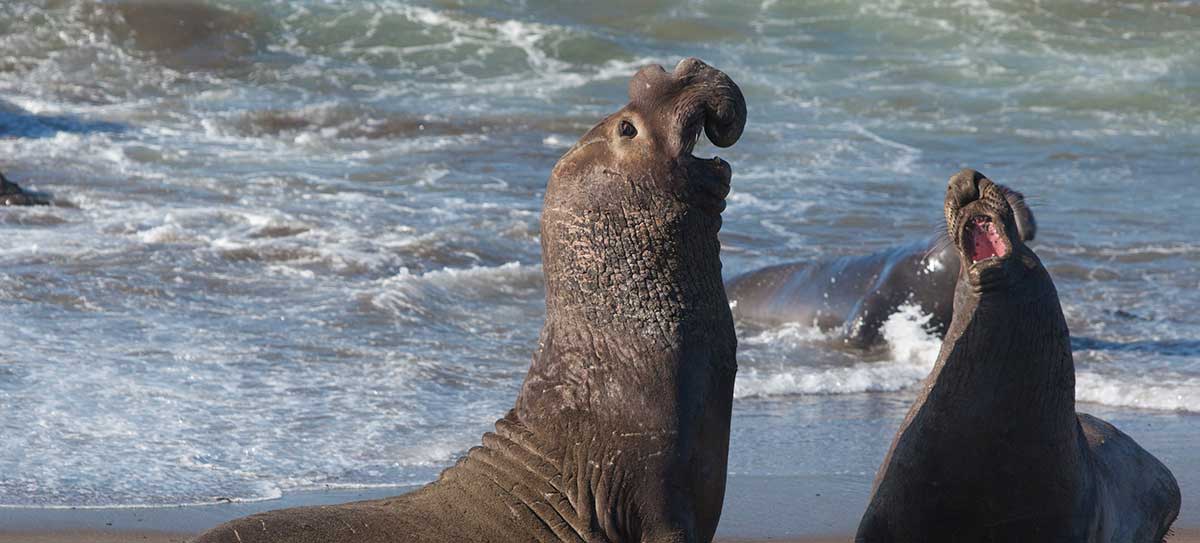 Northern Elephant Seals are named because the adult males have large snouts resembling an elephant's trunk that begins to develop at about three to five years of age and is fully developed by 7 to 9 years of age.
Northern Elephant Seals are named because the adult males have large snouts resembling an elephant's trunk that begins to develop at about three to five years of age and is fully developed by 7 to 9 years of age.
Adult males can reach over 13 feet long (4 meters) and weigh up to 4,500 pounds (2,041 kilograms). Females are notably smaller, reaching only to 10 feet in length (3 meters) and weighing up to 1,300 pounds (590 kilograms). After the Southern Elephant Seal, the Northern Elephant Seal is the second largest seal in the world. Elephant seals are true seals or phocids. They have ear holes and short front flippers, broad faces, and large eyes. They move on land by “galumphing” or flopping on their bellies.
Not so long ago, Elephant seals were almost driven to extinction. Starting in the 1700s, when whales were becoming scarce from prolific whaling, whalers began hunting Elephant Seals until they were driven to near extinction for their oil-rich blubber. By 1910, there were less than 100 elephant seals to be found on Guadalupe Island in Baja California which prompted the Mexican government in 1922 to take protective measures and granted these seals protected status. Following the Mexican government’s intervention, the United States followed suit and the remaining Elephant Seals found a safe haven among California’s coastal islands, including the Channel Islands, Año Nuevo Island, and the Farallon Islands off the coast of San Francisco. Today, in the North Pacific, from Baja California to the Aleutian Islands, Northern Elephant Seals thrive with an estimated number to be 150,000 seals, with 124,000 living in California waters, and rebounding to the approximate size they were before they were nearly hunted to extinction in 1910. Their breeding grounds are offshore islands, such as the Channel Islands, Año Nuevo, Point Reyes, and Piedras Blancas in San Simeon.
From Pismo Beach, you can take a picturesque drive north on California Highway 1 to the Piedra Blancas Elephant Seal Rookery in San Simeon to observe these magnificent creatures. San Simeon is also home to Hearst Castle, so maybe you will want to make a daytrip of it and visit both attractions! The rookery is a 58 minute drive and 51.2 miles from Pismo Beach.
Pacific Harbor Seals
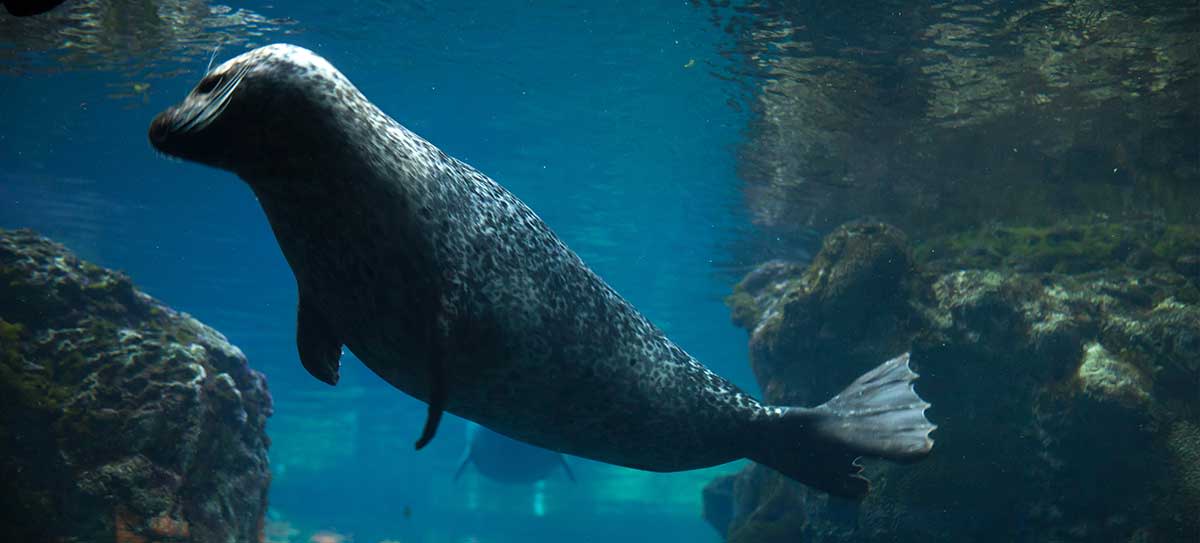 In both the Pacific and Atlantic oceans, Harbor Seals are found north of the equator. In the Pacific, they are found from Alaska to Baja California, favoring nearshore coastal waters near rocky islands, sandy beaches, mudflats, bays and estuaries. These seals spend half of their lives in water and the other half on land. Typically, harbor seals dive 3 to 7 minutes in relatively shallow water, however, they are capable of diving as deep as 1,500 feet (457 meters), and holding their breath up to 40 minutes long. Pacific harbor seals share two important characteristics with Northern Elephant Seals: they are crawling seals, as their small flippers help them to move on land by galumphing; and, they have ear holes like Elephant Seals, not ear flaps as do California Sea Lions. Their spotted coats come in a variety of colors from white or silver-gray to dark brown to black. Harbor Seals grow to be 5 to 6 feet long (1 meter to 2 meters) and can weigh up to 300 pounds (136 kilograms) with male seals being slightly larger than females. At birth, harbor seal pups weigh only 20 to 24 pounds (9 kilograms to 11 kilograms), with premature pups retaining their fluffy, white lanugo coat, that is normally shed in utero before birth by pups born full-term. Newborn pups are able to swim at birth, however, they do enjoy riding on their mother’s backs. Weaning from their mother begins early after four weeks of age. Harbor seals enjoy a diet of fish, octopus, and squid. Harbor seals have a curious nature and are seen watching humans walking on beaches, however, if they are disturbed, they will abandon their favorite sites and even their pups.
In both the Pacific and Atlantic oceans, Harbor Seals are found north of the equator. In the Pacific, they are found from Alaska to Baja California, favoring nearshore coastal waters near rocky islands, sandy beaches, mudflats, bays and estuaries. These seals spend half of their lives in water and the other half on land. Typically, harbor seals dive 3 to 7 minutes in relatively shallow water, however, they are capable of diving as deep as 1,500 feet (457 meters), and holding their breath up to 40 minutes long. Pacific harbor seals share two important characteristics with Northern Elephant Seals: they are crawling seals, as their small flippers help them to move on land by galumphing; and, they have ear holes like Elephant Seals, not ear flaps as do California Sea Lions. Their spotted coats come in a variety of colors from white or silver-gray to dark brown to black. Harbor Seals grow to be 5 to 6 feet long (1 meter to 2 meters) and can weigh up to 300 pounds (136 kilograms) with male seals being slightly larger than females. At birth, harbor seal pups weigh only 20 to 24 pounds (9 kilograms to 11 kilograms), with premature pups retaining their fluffy, white lanugo coat, that is normally shed in utero before birth by pups born full-term. Newborn pups are able to swim at birth, however, they do enjoy riding on their mother’s backs. Weaning from their mother begins early after four weeks of age. Harbor seals enjoy a diet of fish, octopus, and squid. Harbor seals have a curious nature and are seen watching humans walking on beaches, however, if they are disturbed, they will abandon their favorite sites and even their pups.
It is estimated that there are 500,000 Harbor Seals worldwide, with about 34,000 living in the coastal waters of California.
At Pismo Beach, Harbor Seals can be seen from the Pismo Pier and the shore. To get a closer look and see the seals resting and cavorting on docks, boats, and buoys, take a short drive to the San Luis Bay Harbor in Avila Beach.
California Sea Lions
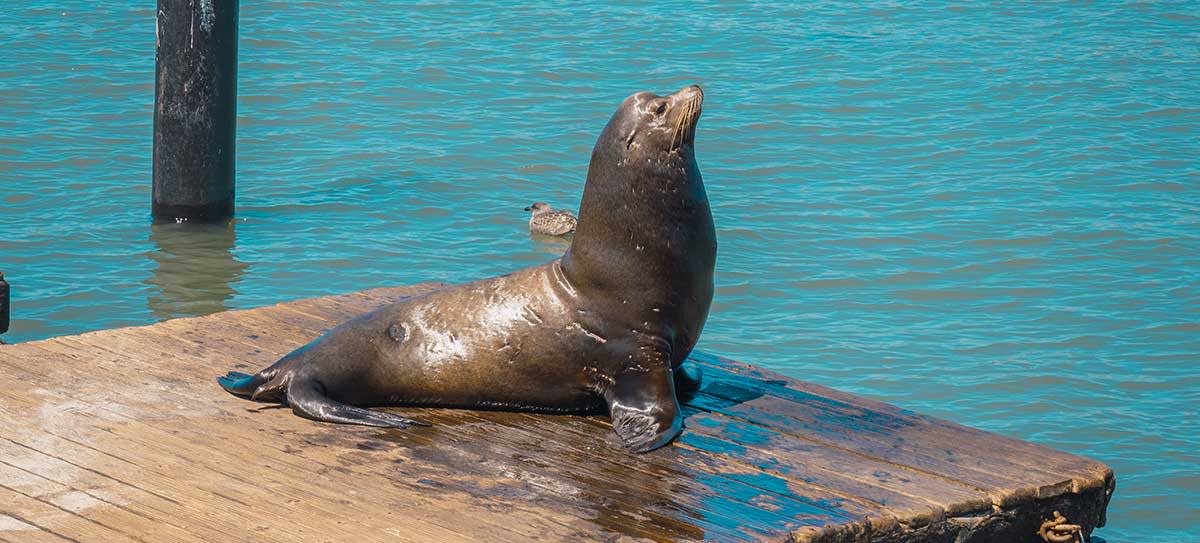 California sea lions are members of the otariid or walking seal family because they have large flippers that they use to walk on land. Known for their intelligence and playfulness, California sea lions' faces resemble dogs; they are also very vocal and love to bark! Additionally, they have external ear flaps, again, similar to dogs, that set them apart from other seals.
California sea lions are members of the otariid or walking seal family because they have large flippers that they use to walk on land. Known for their intelligence and playfulness, California sea lions' faces resemble dogs; they are also very vocal and love to bark! Additionally, they have external ear flaps, again, similar to dogs, that set them apart from other seals.
Males and females differ in color and size. Male sea lions’ fur is chocolate brown and males are much larger than females, growing up to 600 to 850 pounds (272 kilograms to 386 kilograms), and 7 feet in length (2 meters). Females are golden brown, growing to only 200 to 250 pounds (91 kilograms to 113 kilograms) and up to 6 feet in length (1 meters). At around 4 years of age, male Sea Lions begin to develop a sagittal crest or a bony bump on top of their skull as they reach sexual maturity at 5 years of age. Female California sea lions reach sexual maturity around 3 years of age.
Each year, sea lions return to their rookeries in Southern and Central California where females give birth to their pups in early summer; most California sea lions are born in the first two weeks of June. Newborn pups weigh 13 to 20 pounds (6 kilograms to 9 kilograms). Mother seals can find their pups on crowded rookeries through their familiar smell and unique vocalizations and pups learn to recognize their mother’s smell and unique vocalizations as well. A mother sea lion nurses her pup for 1 to 2 days, then leaves the pup in the rookery while she visits feeding areas at sea for two to five days. During this time, the pup doesn't eat. The pups stay with their mother until they are one year old for both nursing and learning how to survive on their own. The pups stay for six to twelve months or until the arrival of her next pup.
California sea lions feed on squid, octopus and small schooling fish like herring, anchovies and sardines. In the marine food chain, Sea lions are preyed upon by orca whales and great white sharks. Other threats to Seal Lions include humans shooting the seal lions and by sea lions becoming entangled in our improperly disposed of trash that is destroying their marine environment.
California sea lions are found from north British Columbia to the southern tip of Baja California, breeding mainly on offshore islands, from Southern California's Channel Islands to Mexico. Being social animals, California Sea lions rest closely together. At sea, they can be seen floating together in groups called “rafts.” On land, near the shore, they can be found floating on buoys, docks, and boats. In the water, they can be seen jumping out of the water, swimming, sleeping, and at times, even surfing the waves. The California sea lion population is estimated at around 257,000 individuals.
California Sea Lions can be observed in many coastal outlooks in Pismo Beach and can be seen from the pier, the shore, kayaks, and other watercraft. Remember to always observe the Marine Wildlife Viewing Safety Guidelines from both land and sea!
Southern Sea Otters
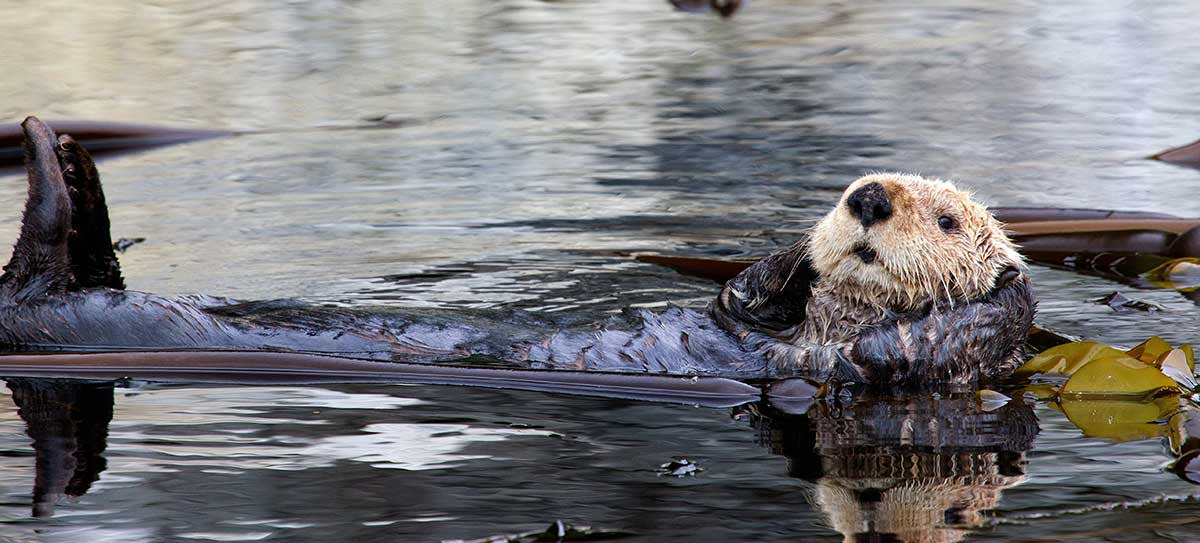 Southern Sea Otters are the smallest marine mammals and are members of the weasel or mustelid family.
Southern Sea Otters are the smallest marine mammals and are members of the weasel or mustelid family.
They have thick brown fur with two layers, an undercoat and longer guard hair making up the outer layer of fur. Otters have no blubber to keep them warm and their thick fur prevents them from getting wet and cold. Their fur is so thick that it traps air against their bodies keeping them warm, like how the weave of a sweater keeps humans warm. Sea otters are social animals with males in one group and females with their pups in another. Adult female southern sea otters weigh 35 to 60 pounds (16 kilograms to 27 kilograms) and males can be up to 90 pounds (41 kilograms). Newborn sea otters weigh 3 to 5 pounds (1 kilogram to 2 kilograms). Sea otters dwell in kelp beds where they use the kelp as an anchor and wrap themselves in the kelp when resting. Mothers wrap their babies in kelp, leaving them to float on the surface of the ocean like a buoy while they hunt for food. The fur of sea otter pups traps so much air that they float and are unable to dive. Much of a sea otter mother’s time is spent grooming their pups and carrying them on their chest. Sea otters have pockets under each forearm that they use to carry food they foraged to the surface. They also store rocks in these pockets so that they can use the rocks to crack open shellfish on their midsections while floating on their backs. Sea otters also use rocks to hammer on abalone until the abalone release their grip on the seafloor.
In the past, sea otters were hunted for their luxurious fur and are now listed as a threatened species. Today, Southern sea otters are constantly threatened by the risk of oil spills, disease, parasites, boat strikes, predation and entanglement. If their fur collects oil, it loses its insulating qualities and subjects the otters to exposure to the elements.
Sea Otters can be seen in Pismo Beach below the cliffs of Dinosaur Caves Park in the kelp beds. They can also be observed at sea level by sea kayaking at a respectful distance through this same area.
This information on marine mammals was sourced from Marine Mammal Center, Monterey Bay Aquarium, National Oceanic and Atmospheric Administration (NOAA) , Pacific Beach Coalition, The Whale Trail, and Whale and Dolphin Conservation USA.



